Africa-Press – Rwanda. While scientists have long wondered how a hammerhead shark is able to survive frigid temperatures when deep-diving for their prey, they may soon no longer need be stumped on the matter.
The hammerhead shark may be the first known fish to hold its breath while plunging for prey, a new study has revealed.
A Thursday-released study has revealed that scalloped hammerhead sharks hold their breath by clamping their gills shut in order to dive over 2,500 feet below surface to conserve their body’s temperature.
Sharks are ectothermic creatures, meaning they are cold-blooded, and as such their body temperatures match the temperature of the water they traverse.
And while this species is known to swim in coastal waters with warmer temperatures, that doesn’t mean they don’t also dive more than 2,600 feet below surface for their prey in temperatures that drop as low as 41 degrees Fahrenheit (5 degrees Celsius).
Mark Royer, a researcher at the University of Hawaii at Manoa and the Hawaii Institute of Marine Biology, has said the most rapid point of heat loss “for any fish, even a high-performance fish, is always at the gills.”
“Imagine you’re on a warm sunny beach, and then you hop out of the warm water and immediately plunge into an ice bath,” explains Royer, who led the study. If the shark can’t maintain its body heat, then it can’t swim, and if water isn’t moving across its gills it essentially drowns.
While some sharks and fish have evolved in having a specialized heat-exchange systems at their gills, such as the mako shark, the great white shark, as well as the tuna and marlin fish, the scalloped hammerhead did not develop this evolutionary trait and must resort to closing both its moth and gills.
Through using a small device, which Royer compared to a Fitbit, the researchers found that once the shark was done diving, it then pitched itself upward at an 80-degree angle and “shoot[s] towards the surface,” and their body temperature remained the same as they returned to the surface.
The shark is believed to be able to hunt while holding its breath for at least 17 minutes.
The new discovery that hammerhead sharks essentially hold their breath while diving for prey “still shocks and baffles” Royer.
The study was published in the journal Science.
For More News And Analysis About Rwanda Follow Africa-Press






